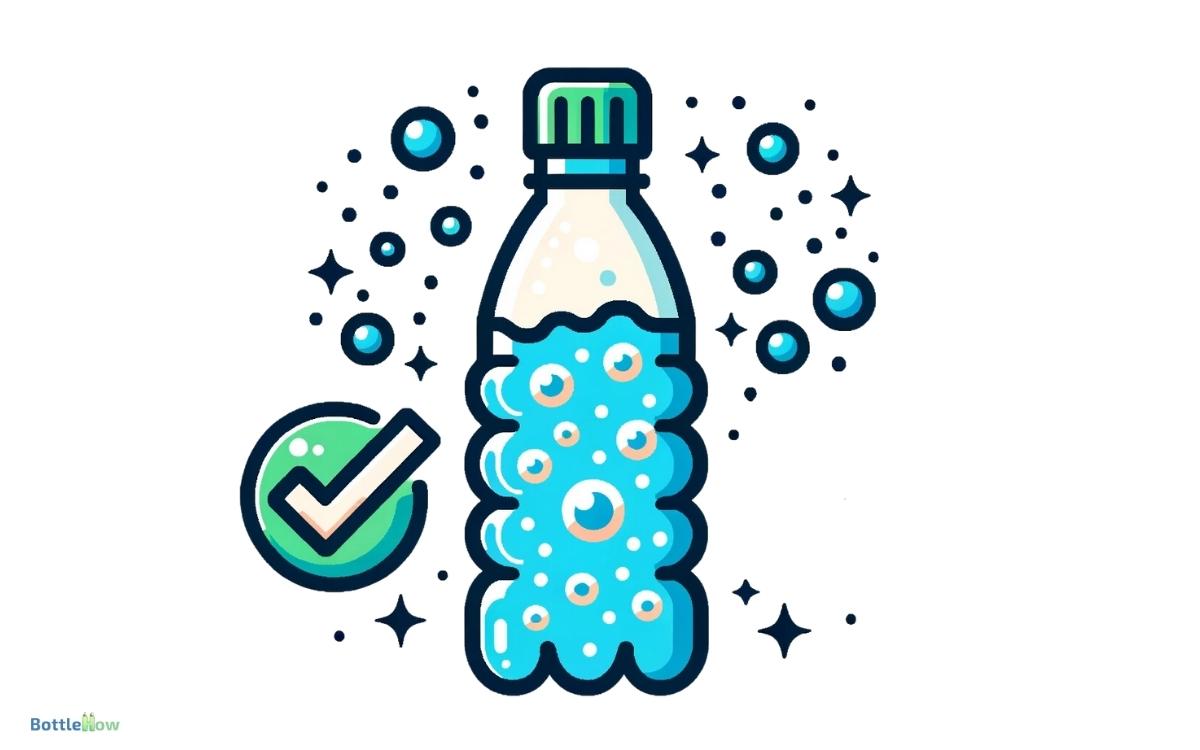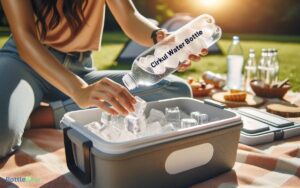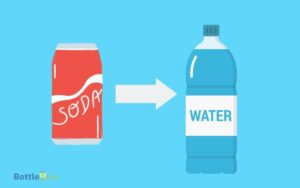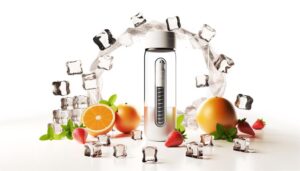Can You Put Fizzy Drinks in a Plastic Water Bottle? Yes!
You can use PET plastic water bottles for fizzy drinks, as they’re engineered to handle carbonation pressure and minimize chemical leaching.
However, using other plastics like LDPE or PVC can risk pressure failure and gas leakage. Factors like pressure, plastic permeability, and temperature fluctuations can affect the drink’s taste and freshness.
Be cautious of potential health risks from chemical leaching, such as BPA and phthalates. Make sure the seal is tight to maintain carbonation.
For best results, store the bottle upright and keep it cool. If you’re interested, there’s more to uncover about selecting the best storage options.

Key Takeaways
Chemical Composition of Plastic
Understanding the chemical composition of plastic is essential for determining its suitability for storing fizzy drinks.
You need to know that plastics commonly used in water bottles, such as polyethylene terephthalate (PET), have specific properties.
PET is chosen for its strength, durability, and resistance to carbonic acid, which is found in fizzy drinks.
However, you should also consider potential leaching of chemicals like antimony and phthalates, which can occur under certain conditions. These chemicals can affect both the taste and safety of the beverage.
Carbonation and Pressure
Carbonation in fizzy drinks generates significant internal pressure, which can affect the structural integrity of a plastic water bottle.
When you seal a carbonated beverage, the dissolved CO2 releases gas, increasing internal pressure.
Most plastic water bottles are designed for non-carbonated liquids and mightn’t withstand this added pressure. The plastic can stretch, deform, or even burst if the pressure becomes too high.
Additionally, the bottle’s cap may not create a perfect seal, leading to gas leakage and potential spillage.
To evaluate suitability, consider the bottle’s material and design specifications. PET bottles, often used for carbonated beverages, are engineered to handle higher pressures. Always confirm that the bottle can safely contain the carbonation levels of your specific drink.
Taste and Flavor Changes
When you put fizzy drinks in a plastic water bottle, you’ll often notice a loss of carbonation, which impacts the beverage’s taste.
The plastic material can also alter the drink’s flavor by leaching chemicals. Additionally, residual odors from previous contents may further affect the overall taste experience.
Loss of Carbonation
Placing fizzy drinks in a plastic water bottle often results in a significant loss of carbonation, leading to noticeable changes in taste and flavor.
The primary reason for this is that plastic bottles are usually not designed to withstand the pressure exerted by carbonated beverages.
Over time, the carbon dioxide that gives the drink its fizz escapes through the bottle’s material and cap.
Additionally, plastic’s permeability to gases accelerates this process. Consequently, the drink loses its effervescence and becomes flat.
You’ll find that the diminished carbonation alters the overall sensory experience, making the drink less enjoyable.
For maintaining peak carbonation levels, it’s advisable to use containers specifically designed for carbonated drinks, such as glass bottles or specialized plastic bottles.
Altered Beverage Taste
The loss of carbonation not only affects the drink’s effervescence but also significantly alters its taste and flavor profile.
When you transfer a fizzy drink to a plastic water bottle, several chemical and physical changes occur that compromise the beverage’s original taste.
- Dissolution of CO2: Decreased carbonation leads to a flatter taste.
- Temperature Variations: Plastic bottles often don’t insulate well, causing temperature changes that can alter the flavor.
- Chemical Interactions: Plastic materials may leach compounds that subtly change the drink’s taste.
- Oxidation: Exposure to air can cause oxidation, which degrades flavor compounds.
These factors collectively diminish the sensory experience, making the drink less enjoyable and altering its intended flavor profile.
Plastic Bottle Odor
Transferring fizzy drinks to a plastic water bottle can introduce unwanted odors that further degrade the beverage’s taste and flavor.
Plastic bottles, especially those not designed for sodas, can absorb and retain odors from previous uses.
When you pour a fizzy drink into such a bottle, these residual odors can mix with the beverage, altering its intended aroma and taste profile.
Additionally, certain chemicals in the plastic can leach into the drink, exacerbating these changes.
This interaction is more pronounced with carbonated beverages due to their acidic nature, which can accelerate the leaching process.
Consequently, you might notice a significant difference in the taste and overall quality of your fizzy drink when using a plastic water bottle.
Impact on Freshness
Storing fizzy drinks in a plastic water bottle can significantly impact the beverage’s carbonation levels and overall freshness.
Plastic is more permeable to gases compared to glass or metal, allowing carbon dioxide to escape more quickly. This permeability accelerates the loss of carbonation, leading to a flat drink.
Additionally, plastic can absorb odors and flavors, altering the beverage’s intended taste profile.
Consider the following factors:
- Gas Permeability: Plastic allows carbon dioxide to escape, reducing carbonation.
- Odor Absorption: Plastic can absorb ambient odors, affecting taste.
- Flavor Transfer: Residual flavors from previous contents can mix with the drink.
- Temperature Sensitivity: Plastic bottles can deform under high temperatures, potentially compromising sealing and freshness.
Understanding these factors helps you make informed decisions about beverage storage.
Potential Health Risks
When you put fizzy drinks in a plastic water bottle, you’re exposing yourself to potential health risks.
Chemical leaching from the plastic can introduce harmful substances into the beverage. Additionally, the bottle’s design may harbor bacteria, increasing the risk of contamination.
Chemical Leaching Risks
Chemical leaching from plastic water bottles into fizzy drinks can introduce harmful compounds like BPA and phthalates into your beverage. These chemicals are known to disrupt endocrine functions and pose various health risks.
When you store carbonated drinks in plastic bottles, the acidic and pressurized environment can increase the rate of chemical leaching.
This exposure can lead to several potential health issues:
- Hormonal Imbalances: BPA and phthalates can mimic or interfere with your body’s hormones.
- Reproductive Harm: These compounds are linked to reduced fertility and developmental problems.
- Increased Cancer Risk: Long-term exposure may elevate your risk of cancers, particularly breast and prostate.
- Metabolic Disorders: Chemical leaching has been associated with obesity and diabetes.
Understanding these risks can help you make safer storage choices.
Bacterial Contamination Concerns
You should be aware that using plastic water bottles for fizzy drinks can create an environment conducive to bacterial growth, posing significant health risks. Over time, tiny scratches inside the bottle can trap residues and make it even easier for bacteria to thrive. This raises concerns not only for fizzy drinks but also for other hot beverages—for instance, can you put coffee in plastic without risking chemical leaching or further bacterial contamination? Using reusable, BPA-free bottles designed for different beverages is a safer and more sustainable choice.
The combination of sugar content and carbonation in fizzy drinks can accelerate bacterial proliferation within the bottle.
Additionally, plastic surfaces can develop micro-scratches over time, which can harbor bacteria and make thorough cleaning difficult.
When you repeatedly use these bottles without proper sterilization, the risk of ingesting harmful pathogens increases. Furthermore, improper sealing can lead to contamination from external sources.
For best safety, it’s essential to use bottles designed for fizzy drinks or consider single-use options to minimize bacterial contamination. Maintaining rigorous hygiene practices when handling any beverage container is essential.
Environmental Considerations
Plastic water bottles contribute substantially to environmental pollution, especially when used and discarded frequently for fizzy drinks.
Their impact is multifaceted and concerning:
- Plastic Waste: Single-use bottles often end up in landfills or oceans, exacerbating pollution.
- Resource Depletion: Producing plastic bottles consumes significant fossil fuels and water.
- Carbon Footprint: Manufacturing and transporting plastic bottles release considerable greenhouse gases.
- Microplastics: Over time, plastic bottles break down into microplastics, which contaminate ecosystems and enter the food chain.
Using plastic water bottles for fizzy drinks further exacerbates these issues due to the increased likelihood of disposal after a single use. Hence, considering alternatives or reducing usage can greatly mitigate environmental harm.
Suitable Plastic Types
Selecting the appropriate type of plastic for fizzy drinks is essential to ensuring safety and maintaining beverage quality.
You should consider using polyethylene terephthalate (PET) or high-density polyethylene (HDPE).
PET is commonly used because it provides excellent carbonation retention and clarity, making it ideal for fizzy drinks. HDPE, while less clear, offers superior chemical resistance and is more robust against physical stress. Both types prevent gas permeability, which is vital for maintaining carbonation.
Avoid using low-density polyethylene (LDPE) or polyvinyl chloride (PVC) as they lack the necessary strength and gas barrier properties. By choosing the right plastic, you’ll guarantee the drink remains fizzy and safe for consumption.
Temperature Effects
When you store fizzy drinks in a plastic water bottle, temperature variations can greatly impact the bottle’s integrity.
Cold drinks can cause the liquid to expand, while heat can increase internal pressure, potentially leading to leaks or bursts.
Additionally, fluctuating temperatures could compromise the stability of the plastic, affecting its durability and safety.
Cold Drink Expansion
Temperature fluctuations can cause fizzy drinks to expand and contract, potentially compromising the integrity of a plastic water bottle.
When you store soda in a plastic bottle and expose it to cold temperatures, the liquid and gas inside contract.
This contraction can lead to a temporary reduction in internal pressure. However, once the temperature rises again, the drink will expand.
This repeated cycle of expansion and contraction can weaken the plastic over time.
Consider the following effects:
- Material stress: Repeated expansion and contraction can stress the plastic.
- Seal integrity: Fluctuations can affect the bottle’s seal, leading to leaks.
- Structural deformation: The bottle may deform, impacting its shape and stability.
- Longevity: The bottle’s lifespan may reduce due to material fatigue.
Heat-Induced Pressure
Rising temperatures can cause the gas in fizzy drinks to expand, increasing internal pressure and potentially leading to bottle deformation or rupture.
This is especially critical when using plastic water bottles, which are not designed to handle high-pressure conditions.
| Temperature (°C) | Internal Pressure (kPa) |
|---|---|
| 20 | 150 |
| 40 | 200 |
| 60 | 250 |
You can see that as the temperature rises, the internal pressure increases considerably. Plastic bottles have a threshold for pressure, beyond which they might fail.
This failure can result in leaks or even full-blown ruptures, posing risks to safety and cleanliness. Always consider temperature fluctuations when storing fizzy drinks in plastic bottles.
Temperature Stability Concerns
Fluctuating temperatures can compromise the structural integrity of plastic water bottles when they contain fizzy drinks.
When a bottle is exposed to varying temperatures, the plastic may expand and contract, leading to potential weaknesses or even ruptures.
Carbonation pressure increases with heat, exacerbating these effects. Conversely, cold temperatures can make the plastic more brittle, increasing the likelihood of cracks or breaks.
- Heat Expansion: Rising temperatures cause the plastic to expand, weakening the bottle.
- Cold Contraction: Lower temperatures make the plastic more brittle and prone to cracking.
- Pressure Build-Up: Heat intensifies carbonation pressure, stressing the bottle further.
- Material Fatigue: Repeated temperature shifts can degrade the plastic over time.
Understanding these temperature effects helps ensure safe storage and usage of fizzy drinks in plastic bottles.
Storage Duration
The duration that a fizzy drink can be stored in a plastic water bottle largely depends on the bottle’s material and its ability to retain carbonation.
PET (Polyethylene Terephthalate) bottles are typically better at preserving carbonation than LDPE (Low-Density Polyethylene) bottles.
You’ll notice that carbonation loss is a significant factor affecting storage duration. When CO2 escapes, the drink becomes flat.
Additionally, the bottle’s seal integrity is important; a compromised seal accelerates CO2 loss. Temperature fluctuations can also impact storage duration; higher temperatures increase the rate of carbonation loss.
Typically, a properly sealed PET bottle can maintain carbonation for several days, whereas an LDPE bottle might only last a day or two before noticeable changes occur.
Practical Tips
Guaranteeing ideal carbonation retention in a plastic water bottle involves selecting the correct bottle type and maintaining a consistent temperature. Opt for bottles specifically designed to hold carbonated beverages.
These bottles are typically made of thicker, more durable plastic that can withstand the pressure from carbonation.
Temperature control is critical; store your fizzy drink in a cool environment to prevent gas expansion and leakage.
- Bottle Type: Use bottles meant for carbonated drinks.
- Temperature: Keep the bottle cool to maintain carbonation.
- Cap Tightness: Ensure the cap is tightly sealed to prevent gas escape.
- Storage Position: Store the bottle upright to minimize surface area exposure and reduce pressure on the cap.
Alternatives to Plastic Bottles
Often, considering alternatives to plastic bottles can lead to more sustainable and effective options for storing fizzy drinks.
Stainless steel bottles offer durability and excellent pressure resistance, preventing leaks and maintaining carbonation.
Glass bottles are another viable option; they’re chemically inert, ensuring no flavor alteration, although they require careful handling due to their fragility.
Aluminum cans are lightweight and highly recyclable, providing a good balance between practicality and environmental impact.
Silicone bottles, while less common, are flexible and reusable, but may not offer the same level of carbonation retention.
Each alternative has its pros and cons, so your choice will depend on specific needs, such as portability, durability, and environmental considerations. By evaluating these options, you can make a more informed decision.
Conclusion
Imagine pouring a fizzy drink into a plastic water bottle, much like placing a lion in a cage too small.
The pressure builds, the carbonation struggles, and the drink loses its freshness and flavor. Studies show plastic can leach chemicals under such stress, posing potential health risks.
By understanding the science behind this interaction, you can make informed choices, opting for more suitable containers to maintain both the drink’s integrity and your well-being.






